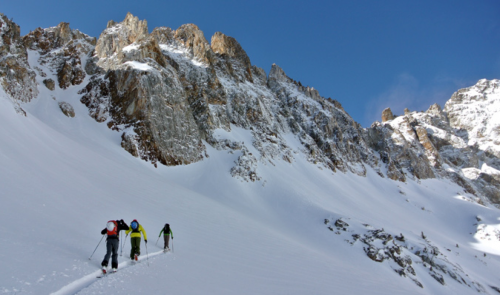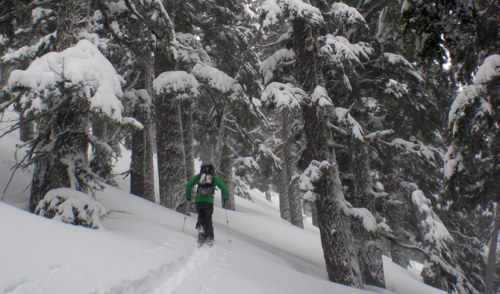Go slow to go fast
While backcountry skiing or riding, we tend to spend more time going up than down. And, simply put, skinning done poorly is not fun. There are three primary ingredients to a good day of touring: establishing a proper pace, setting an appropriate skintrack angle and avoiding kick turns whenever possible. The reality of earning your turns is that more than half of your time in the backcountry will be spent going uphill. If you race through the up, the day will end sooner and with fewer turns. Taking short cuts will just cut the day short. You’ve likely come into the backcountry to escape the rat race, so learn to enjoy the climb up and the whole experience will get a lot better. Here’s how.

PACING
There is an old adage in the mountains: “Go slow to go fast,” which can also be applied to good pacing while skinning. Racing around like a skimo junky is not the way to enjoy a long day of skiing.
Most people can average 1, 000 vertical feet an hour for a long day of touring. For some perspective, walking up a flight of stairs in 30 seconds is a pace of 1,200 vertical feet an hour. This feels slow, but will allow you to cover a lot of ground. Take a five-minute break every hour, and you’ll manage a good average and stay fueled up enough to do it all day. If you’re out for six hours, you’ll get 5,000 feet of skiing (with descents and transitions) in. And that’s a good day of backcountry skiing.
ANGLE
Going straight up the mountain is typically the most direct route, and the most direct route can seem like the fastest, but there are some flaws to this logic while backcountry skiing.
With each step, you lift the weight of most of your body (and equipment) over the vertical distance gained. The straighter up the hill you travel, the greater the vertical distance that comes with each step, and to lift the same amount of weight over a greater distance requires more work.
Some like to say 14 degrees of inclination is the most efficient skintrack. But an easier gauge is your ability to talk. If you are making big steps and find yourself unable to talk in full sentences—even though you are moving slowly—you probably need to put in a shallower track. The ideal step should not feel like walking up steps, but more like sliding across a slippery floor.

KICK TURNS
Kick turns are tricky moments of insecurity and inefficiency that will break the rhythm of your stride and make a group bunch up at the corners. But avoiding them is easier said than done, and setting a skintrack that doesn’t use kick turns is an art.
As you climb, look uphill at the terrain ahead, keeping and eye out for benches, the downhill sides of trees and small features like the tops of rocks and buried stumps. Use these places to make your turns.
Ideally, you want to be able to step through each turn without a big kicking motion, so step through the turn with a sequence of converging and diverging steps. If you need to lift your ski off the snow completely, focus on lifting your heel toward your butt rather than your knee to your chest. This will help the tail of the ski come free of the snow.
Someone once told me to imagine where a train would run through the terrain and put the track there. Wind up the mountain gracefully, making a clean line with elegant curves. And if corners are needed, put them on the flattest terrain possible.
—
Author Donny Roth is an AMGA-certified ski guide and professional skier. He writes about his adventures at independent-descents.com. Learn more about skiing with him in Chile at chile-powder-adventures.com.










Comments